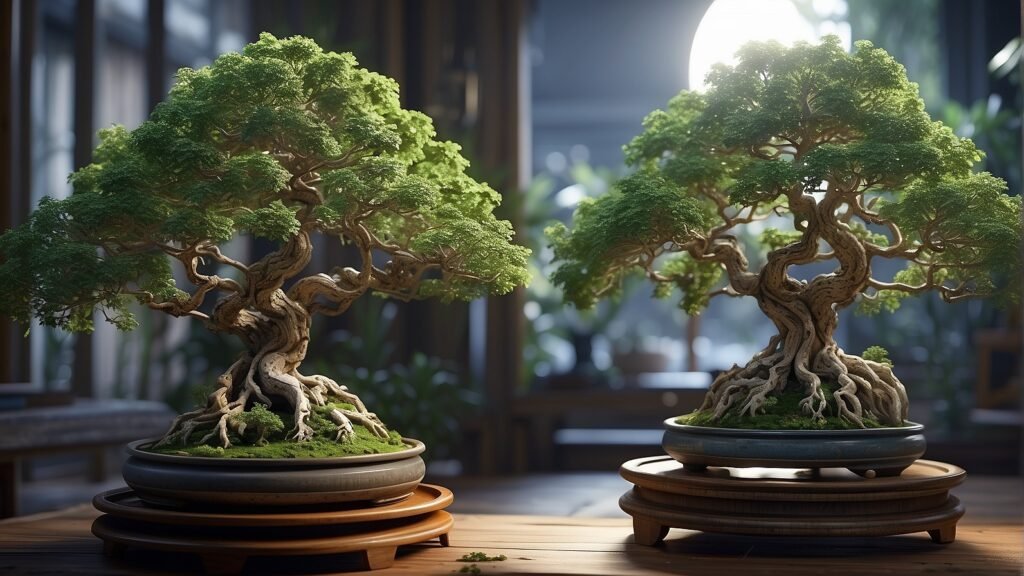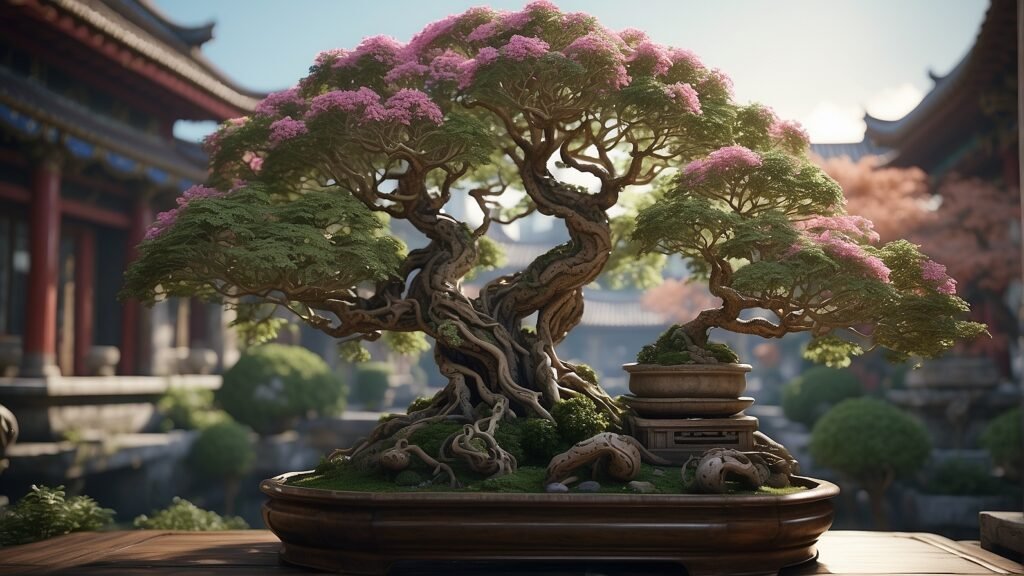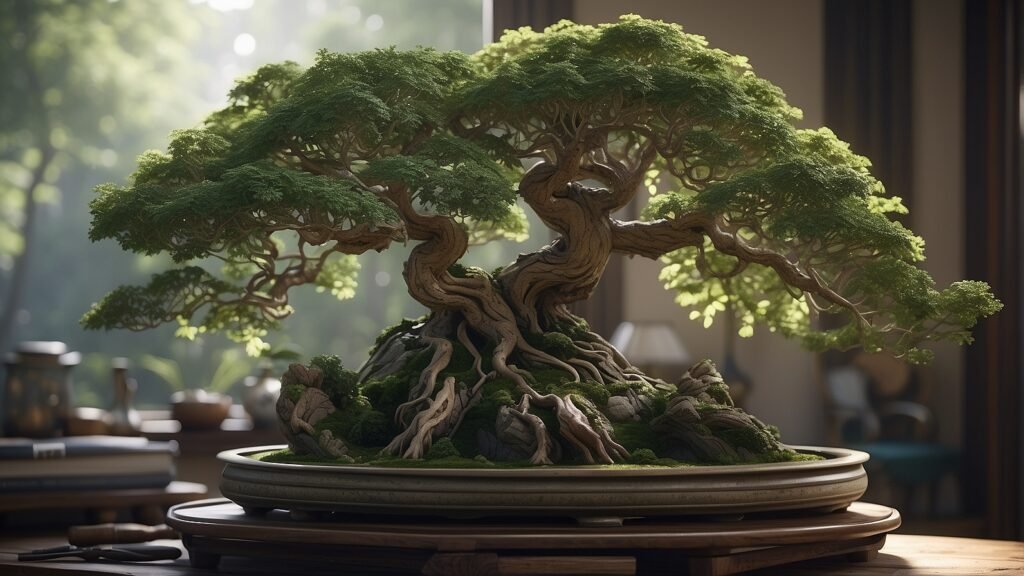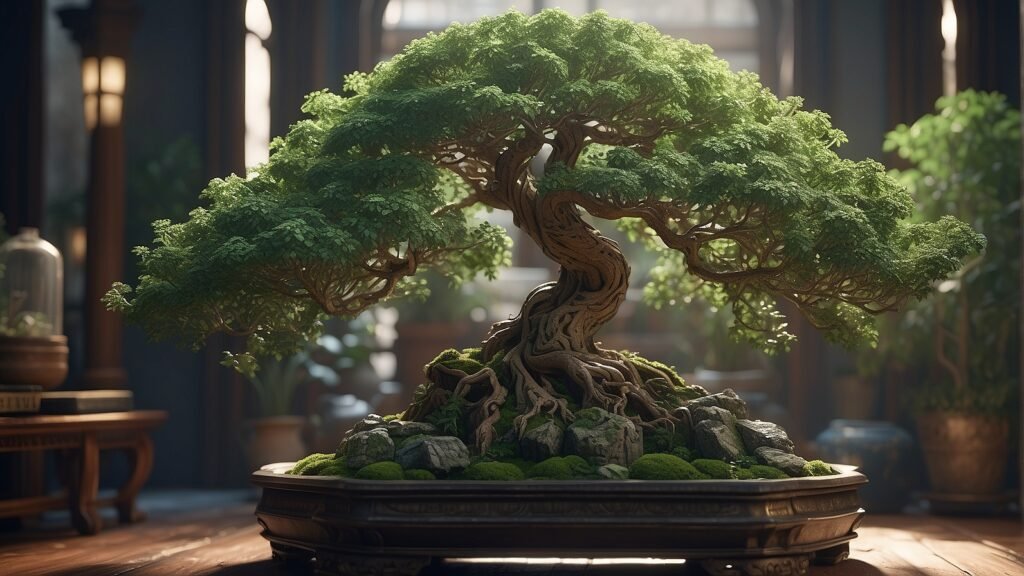Introduction
Let’s dive into the world of Bonsai, specifically the Ming Aralia Bonsai. This isn’t just a plant; it’s a story of nature, patience, and artistic expression all wrapped up in one.

What is Ming Aralia Bonsai?
Ming Aralia Bonsai is a unique type of Bonsai tree that hails from the Polyscias family. Its origin? The beautiful and diverse landscapes of the Pacific islands. With its delicate leaves and intricate branches, it’s no wonder this plant has caught the eyes of Bonsai enthusiasts worldwide!
Key Features of Ming Aralia
Here are some of the standout features of the Ming Aralia Bonsai:
- Leaf Structure: The leaves are thin, feathery, and have an intricate design. It’s like a mini forest on each branch!
- Bark Texture: The bark is smooth and light-colored, giving it a serene, peaceful look.
- Growth Pattern: Ming Aralia Bonsai grows in an upright pattern, with branches stretching outwards in a beautiful display.
Why Choose Ming Aralia Bonsai?
Ming Aralia Bonsai is more than just a plant—it’s an expression of art and nature. It brings a sense of tranquillity to your space, and caring for it can be a rewarding journey. Plus, its unique features make it a standout addition to any Bonsai collection.
So, whether you’re a seasoned Bonsai enthusiast or just starting, the Ming Aralia Bonsai is a fantastic choice. It’s a beautiful blend of nature’s simplicity and human creativity. And remember, each Bonsai has its own story—what will yours be?
Understanding Ming Aralia
The Ming Aralia, scientific name Polyscias fruticosa, is a tropical evergreen shrub that’s popular for its exquisite beauty and distinctive features. Let’s delve into the world of Ming Aralia.

Appearance of Ming Aralia
Ming Aralia is renowned for its impressive height, often growing up to 6-8 feet indoors. It sports a slender yet sturdy trunk that branches out to form a dense canopy of leaves. The leaves are its crowning glory – they’re finely divided, giving them a feathery appearance and their lush green color adds to the plant’s visual appeal.
Varieties of Ming Aralia
There are several varieties of Ming Aralia, each with its unique charm:
- Ming Gold: This variant stands out with its vibrant golden-yellow leaves. It’s a stunning sight to behold, especially when the sunlight hits the leaves.
- Parsley Aralia: Known for its smaller, parsley-like leaves, this variety has a more compact growth habit, making it perfect for smaller spaces.
Ming Aralia as a Bonsai
Ming Aralia makes an excellent bonsai for several reasons:
- Appearance: The tree’s delicate, feathery leaves and intricate branching patterns make it visually striking, perfect for a bonsai display.
- Size: Even though it can grow quite tall, Ming Aralia responds well to pruning, allowing you to maintain it at your desired size.
- Adaptability: It can thrive in a variety of conditions, which is a valuable trait for any bonsai plant.
- Growth Habit: Its upright growth habit and ability to branch out extensively make it suitable for various bonsai styles, including the formal upright (Chokkan) and the slanting (Shakan) styles.
Ideal Conditions for Growing Ming Aralia Bonsai
Here’s what the Ming Aralia Bonsai really loves:

- Light: Ming Aralia enjoys bright, indirect sunlight. A spot near a window where it can bask in the sun without getting burnt is ideal.
- Water: Keep the soil moist. Be sure to water it thoroughly and let it drain to prevent waterlogging.
- Temperature: This bonsai is a fan of warmer climates. Try to maintain an environment between 60-85°F (15-29°C).
- Soil: A well-draining soil is key. Consider a mix of peat moss, perlite, and sand for optimal growth.
| Light | Water | Temperature | Soil |
|---|---|---|---|
| Bright, indirect | Moist | 60-85°F (15-29°C) | Well-draining |
Common Challenges and Solutions
Every plant has its quirks, and the Ming Aralia Bonsai is no different. Here are a few challenges you might face and some tips on how to overcome them:
- Leaf Drop: It’s normal for Ming Aralia to shed a few leaves, especially when adjusting to a new environment. If it’s excessive, it might be due to overwatering or low light. Adjust these factors and observe the plant’s response.
- Pests: Spider mites and scale can sometimes be a problem. Regularly check your plant for these tiny critters. If you spot any, use a mild insecticidal soap to get rid of them.
Maintaining Health and Aesthetics
Keeping your Ming Aralia Bonsai healthy and attractive is a rewarding task. Here are some tips:
- Pruning: Regular pruning helps maintain the shape of your Ming Aralia Bonsai and promotes denser foliage. Remember, it’s an art as much as it is a science.
- Fertilizing: Feed your bonsai with a balanced liquid fertilizer every two weeks during the growing season. This keeps it healthy and vibrant.
- Repotting: Every couple of years, you might need to repot your bonsai to refresh the soil and give the roots some room to grow.
The Art and Science of Styling Ming Aralia
Styling a bonsai is where creativity meets botany. It’s all about understanding how your Ming Aralia grows and using that knowledge to shape it into something beautiful.

Pruning and Shaping Your Ming Aralia
let’s get down to business. Here’s how you can prune and shape your Ming Aralia Bonsai:
- Timing: Wait until your shoot has sprouted about four or five leaves. That’s when it’s pruning time.
- Technique: Cut the shoots back to one or two leaves. This encourages more branches to grow, giving your bonsai a fuller look.
- Balance: If your bonsai starts to lean towards one side, it’s time to bring out your pruning shears. Cut just above an inward-facing node to encourage growth in that direction. This helps balance out your bonsai.
| Timing | Technique | Balance |
|---|---|---|
| 4-5 leaves on a shoot | Cut back to 1-2 leaves | Prune above an inward-facing node |
Back Budding: A Secret Weapon
Back budding is like a secret weapon for your bonsai. It’s when new buds form on older wood, allowing you to grow branches in places you wouldn’t normally be able to. And guess what? Ming Aralia is pretty good at it!
So, if you’re looking for a way to make your Ming Aralia Bonsai even more visually appealing, give back budding a shot!
When, Why, and How to Report
Repotting your bonsai is an important part of its care. Here’s the lowdown:
- When: Typically, you should report your Ming Aralia every two years.
- Why: Over time, the soil in your bonsai pot can become compacted and depleted of nutrients. Repotting refreshes the soil and gives your plant’s roots room to grow.
- How: Here’s a quick step-by-step guide:
- Carefully remove your bonsai from its pot.
- Trim back about one-third of the root ball to promote new growth.
- Place fresh, well-draining soil in the bottom of the pot.
- Put your bonsai back in the pot and fill in around the roots with more soil.
- Water thoroughly to settle the soil.
| When | Why | How |
|---|---|---|
| Every 2 years | Refresh soil & root space | Remove, trim, soil, replant, water |
Bare Rooting Concerns
Bare rooting means removing all the soil from your plant’s roots during repotting. This can be stressful for the plant, and it’s usually not necessary for Ming Aralia. Instead, just gently loosen the soil around the roots and trim back as needed.
Remember, repotting is like giving your Ming Aralia Bonsai a fresh start. It’s a chance for it to grow stronger and healthier, and it’s an essential part of your journey as a bonsai caretaker. So, don’t be afraid – embrace it, and watch your bonsai thrive!
Ming Aralia Bonsai as Indoor Decor

Perks of Having Ming Aralia as an Indoor Plant
- Air Purifier: Ming Aralia helps clean the air in your home. It’s like having a tiny, leafy air purifier!
- Low Maintenance: It’s pretty easy-going and doesn’t need constant attention. Perfect for busy plant parents!
- Visual Appeal: With its lush leaves and elegant form, it’s a real eye-catcher.
| Air Purifier | Low Maintenance | Visual Appeal |
|---|---|---|
| Cleans the air | Easy to care for | Aesthetically pleasing |
Thriving in Low Light
One of the best things about Ming Aralia? It’s not fussy about light. While it enjoys bright, indirect light, it can also manage just fine in low-light conditions. So, don’t worry if your home isn’t flooded with sunlight – your Ming Aralia will still feel right at home.
Styling Tips
So, how can you incorporate this lovely bonsai into your home decor? Here are a few tips:
- Go Minimal: The Ming Aralia’s intricate form stands out beautifully against minimalist decor.
- Create a Green Corner: Group it with other indoor plants for a lush, green corner that’s sure to turn heads.
- Showcase on Shelves: Place it on a shelf or mantelpiece where it can bask in the spotlight.
Having a Ming Aralia Bonsai in your home is like having a piece of nature’s art in your living room. It’s a unique, stylish, and healthy addition to any home. So why wait? Let the Ming Aralia Bonsai enhance your indoor decor!
Conclusion
And there you have it, folks! The Ming Aralia Bonsai – it’s more than just a plant; it’s a living piece of art, an air purifier, and a testament to nature’s incredible beauty.
This little tree has a big personality. It brings a unique charm to any room with its lush leaves and elegant form. Plus, it’s a low-maintenance pal that can thrive even in low-light conditions. Talk about a triple threat!
But the real beauty of the Ming Aralia Bonsai lies in the journey of growing and caring for it. From reporting to pruning, each step is a chance to connect with nature and learn something new. And the result? A stunning bonsai that you’ve nurtured from the roots up.
So, if you’re ready for a rewarding challenge, why not embark on the journey of growing your own Ming Aralia Bonsai? Trust us, it’s an adventure worth taking. Happy gardening!
Frequently Asked Questions (FAQs)
How often should I water my Ming Aralia Bonsai?
The Ming Aralia Bonsai does not require frequent watering. Aim to water it when the top inch of soil feels dry to the touch.
Can my bonsai survive in low light conditions?
Yes, the Ming Aralia Bonsai can thrive even in low light conditions, although it prefers bright, indirect light.
How often should I repot my bonsai?
Typically, the Ming Aralia Bonsai should be repotted every two years to refresh the soil and give the roots room to grow.
What is back budding, and why is it important?
Back budding is when new buds form on older wood, allowing branches to grow in places they wouldn’t normally. This can make your bonsai more visually appealing.
Is Ming Aralia Bonsai a good indoor plant?
Absolutely, Ming Aralia Bonsai is not only visually appealing but also serves as an air purifier. Plus, it’s low-maintenance, making it perfect for indoor decor.
Further Reading and Resources
- The Ultimate Guide to Barbados Cherry Bonsai Care and Cultivation
- The Art and Care of Colorado Blue Spruce Bonsai: A Comprehensive Guide
- The Enchanting World of Wisteria Bonsai: A Comprehensive Care Guide
- Cultivating the Art of Bonsai Pepper Plants: A Comprehensive Guide
- Exploring the Elegance of Literati Bonsai: A Deep Dive into its Poetic Style
- Cultivating the Jade Succulent Bonsai: A Comprehensive Guide






Wonderful web site Lots of useful info here Im sending it to a few friends ans additionally sharing in delicious And obviously thanks to your effort